
“If the internet was a country; it would be the 4th largest polluter in the world.” This striking insight highlighted by Sustainable Web Manifesto draws attention to the significant, yet often overlooked, environmental impact of our digital actions. Each digital interaction we engage in — every click, swipe, and tap — goes beyond the screen, and carries a tangible environmental footprint.
But what does sustainability mean in spaces where physical tangibility is a foreign concept? Can cognitive biases influence users’ actions and behaviors towards more sustainable decisions? Below I discuss how some of the cognitive biases are utilized to have an impact on environmental sustainability and encourage users towards eco-conscious behaviors. From nudge theory to framing effect, we will explore a variety of real-life examples.
Understanding Sustainable UX Design
“Sustainability is an approach to design and development that focuses on environmental, social, and financial factors that are often never addressed.”
Nathan Shedroff notes in his book Design is the Problem. He emphasizes sustainability as a multifaceted challenge. It aims to create products that are long-lasting, resource-efficient, and beneficial for both the planet and society. This broader perspective suggests that merely focusing on human-centered design as a framework might fall short for long-term environmental goals. Therefore, shifting towards environment-centered design is essential. As Thorsten Jonas, founder of Sustainable UX Design (SUX), advises:
“We need to move from a human to a humanity and environmental centered design approach.”

Addressing sustainable behavior, cognitive biases — systematic deviations from logic in decision-making — significantly can shape our choices. Leveraging these biases in UX design can guide users towards more sustainable behaviors, underscoring the importance of integrating these principles to encourage environmentally friendly actions. Below, I discuss several cognitive biases and demonstrate how they’ve been applied in UX design to foster sustainability.
How Products are Using Cognitive Biases to Promote Sustainable Choices?
Nudge Theory: Through positive reinforcement and subtle hints, it’s possible to influence people’s decisions and actions. Google rearranged their vending machines in its cafeterias by using nudge theory. Bottled water was placed on eye level, and sodas were at the bottom. As a result, they increased water intake by 47%, and decreased calories from drinks by 7%.
Another example is from the Bank of America app where they make the paperless option more visible.

Default Bias: Setting the more sustainable option as the default choice can lead to higher adoption rates since users tend to stick with defaults. Zomato app changed their request for cutlery option to an ‘opt-in’ instead of an ‘opt-out’. According to the data they shared, this small change on their app would help save up to 5,000 kilos of plastic in one day — amounting to nearly 2 million kilos of plastic in a year. However, the user should always have the autonomy to choose another option.
The downside of this approach is it might go unseen by some users, and can result in complaints. To eliminate this issue, and to ensure consistency by service providers, Zomato prompts a feedback question on the app post delivery.

On the other hand, Ubereats notifies and informs the user about their default cutlery option early on.

Framing: The way the information is presented influences how we understand and perceive it. In this example, the slower internet option is framed as a data saver to highlight environmental impact.

Social Proof: As we adapt our behavior based on others, showing users that others are making sustainable choices can encourage them to do the same.
Ecosia, the search engine platform, plants trees with its ad revenues. They are using social proof by showing a counter for trees they planted through their community. It is showcasing other people’s impact through Ecosia.

Scarcity: Highlighting the limited availability of resources can make sustainable options more appealing by invoking a sense of urgency. Uber believes in a shared economy. They use countdown to convince users to order from the same restaurants as previous users and share delivery.

Feedback Loop: Providing immediate feedback on the environmental impact of a user’s action can reinforce sustainable behavior in the future. Image compression platform, Tinypng, informs users how much energy has been saved after their action.

Reciprocity: People are more likely to reciprocate when they receive something. The fashion brand, Patagonia, offers in-store credit if their users sell their second hand Patagonia products on WornWear.
Patagonia is giving something of value to its customers, who in turn might feel more inclined to reciprocate by engaging in the behavior Patagonia is promoting,

Loss Aversion: We tend to avoid potential losses over equal gains. WWF Paper towel dispenser is designed by Simon Wooller for the World Wildlife Foundation. Emphasizing what is lost by not choosing the sustainable option (e.g., more waste, greater environmental impact) can be a powerful motivator.
The dispenser acts as a visual reminder of the greater “loss” of potential trees against what the user gains -the paper towel.

Goal Gradient Effect: Apps that encourage sustainability through gamification, like “Forest,” use the goal gradient effect by allowing users to set personal productivity goals. In the Forest app, users grow virtual trees when they stay focused and avoid using their phones. The added real-world benefit of the app is planting actual trees based on user achievements — coins earned from focus time. You need to complete a set of achievements and collect sufficient coins to plant a real tree.

Sunk Cost Effect: Users are hesitant to withdraw from something they have committed resources to. Forest app utilizes the sunk cost effect by having users grow a virtual tree during focus sessions. Committing to this time grows a virtual tree, but using the phone kills it. This might make users more likely to commit to avoid losing their investment. This method enhances focus and indirectly supports real tree planting, leveraging sunk costs to boost productivity and environmental efforts.

Closing Thoughts
In conclusion, the transformative power of sustainable UX design offers hope in our search to mitigate the environmental impact of our increasingly digital lives. However, the path forward requires more than just design. It demands a continuous commitment to monitoring adoption, ethically balancing influence with autonomy, and overcoming the service limitations that currently hinder these efforts. By embracing these challenges with a forward-thinking and ethically grounded approach, the field of UX design can significantly contribute to a more sustainable world, one digital interaction at a time.
Sources
https://thedecisionlab.com/biases
www.builtformars.com/ux-glossary?variables=e30%3D
🧠Psychology of Design: 106 Cognitive Biases & Principles That Affect Your UX
https://www.nngroup.com/articles/prospect-theory/
Sustainable UX Design: Promoting Behavior through Cognitive Biases was originally published in UX Planet on Medium, where people are continuing the conversation by highlighting and responding to this story.